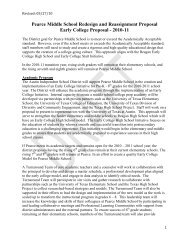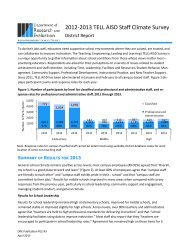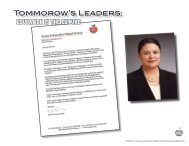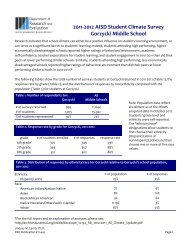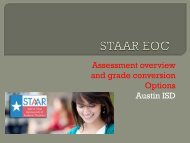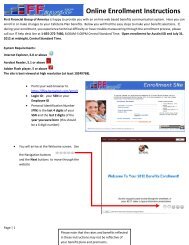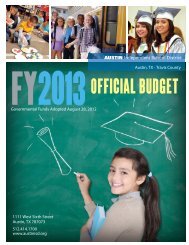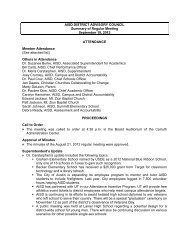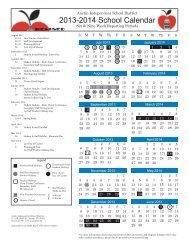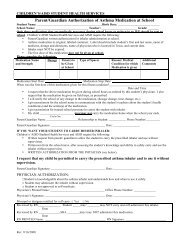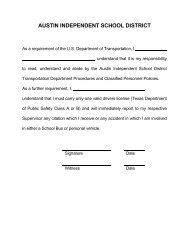District Improvement Plan - Austin ISD
District Improvement Plan - Austin ISD
District Improvement Plan - Austin ISD
You also want an ePaper? Increase the reach of your titles
YUMPU automatically turns print PDFs into web optimized ePapers that Google loves.
<strong>Austin</strong> Independent School <strong>District</strong><br />
<strong>District</strong> <strong>Improvement</strong> <strong>Plan</strong><br />
2010-2011<br />
Board of Trustees<br />
Mark Williams, President<br />
Vincent M. Torres, Vice-President<br />
Lori Moya, Secretary<br />
Tamala Barksdale<br />
Cheryl Bradley<br />
Christine Brister<br />
Sam Guzman<br />
Annette LoVoi<br />
Robert Schneider<br />
Superintendent<br />
Dr. Meria J. Carstarphen<br />
Prepared by the<br />
Office of <strong>Plan</strong>ning and Community Relations<br />
FINAL REVISED VERSION
INTRODUCTION<br />
The 2010-2011 <strong>District</strong> <strong>Improvement</strong> <strong>Plan</strong> (DIP) for A<strong>ISD</strong> was developed with input from<br />
the <strong>District</strong> Advisory Council, prepared by the Office of <strong>Plan</strong>ning and Community<br />
Relations, reviewed by the Office of Accountability, and approved by the<br />
Superintendent’s Senior Cabinet.<br />
On December 14, 2009, the Board of Trustees approved a long-range Strategic <strong>Plan</strong> for<br />
the district. Shortly after, a process was initiated to implement the Strategic <strong>Plan</strong>,<br />
including development of the DIP and Campus <strong>Improvement</strong> <strong>Plan</strong>s for 2010-2011. As<br />
described in more detail on the following pages, the Strategic <strong>Plan</strong> contains goals for<br />
student performance, which equate to the district and campus “performance objectives”<br />
required in state statute to be approved by the Board of Trustees.<br />
The DIP serves two important purposes, which are addressed in two different parts of<br />
this document. Part One of the 2010-2011 DIP describes the district’s Comprehensive<br />
System for Continuous <strong>Improvement</strong>. Part Two provides an Strategic Action <strong>Plan</strong> to<br />
implement the district’s Strategic <strong>Plan</strong> for the year of report.<br />
Over the past several years, the district has accumulated a multi-level monitoring and<br />
reporting system, which is evident in the following pages. While the district wants to<br />
retain a comprehensive system for continuous improvement, it will be important to<br />
ensure that the system is efficient and current. Certain monitoring and reporting<br />
activities will need to be abandoned by the Board – such as Results Policies, Executive<br />
Limitations Reports, and Level Reports – and replaced with one quality monitoring tool.<br />
Part One<br />
COMPREHENSIVE SYSTEM FOR CONTINUOUS IMPROVEMENT<br />
The district’s comprehensive system for continuous improvement is summarized in<br />
Figure 1. The system is accomplished at the district, campus, and individual employee<br />
levels, through establishment of policy, and delivery of a number of long-range,<br />
ongoing, and annual actions. An integral feature of the system is the alignment of all<br />
district planning efforts with the Strategic <strong>Plan</strong>, as depicted in Figure 2.<br />
Policy<br />
Several A<strong>ISD</strong> policies are currently in place to address district and campus planning<br />
and decision-making processes. These policies primarily implement state statutory<br />
requirements found in Chapter 11, Subchapter F, of the Texas Education Code. Specific<br />
district policies are: BQ(Legal), BQA(Legal), BQA(Local), BQB(Legal), BQB(Local), and<br />
BQB(Regulation).<br />
On April 26, 2010, the Board of Trustees adopted policy AE(Local). This policy<br />
implements Key Action Step 1.1 of the Strategic <strong>Plan</strong>, which states “Adopt policy that<br />
articulates the district’s theory of action for teaching and learning, reflecting high<br />
expectations and ensuring alignments with all educational plans and initiatives.”<br />
<strong>Austin</strong> <strong>ISD</strong> Office of <strong>Plan</strong>ning and Community Relations<br />
Page 1
Policy<br />
• <strong>District</strong> and campus<br />
policy and decisionmaking<br />
processes<br />
• Theory of action for<br />
teaching and learning<br />
Figure 1<br />
A<strong>ISD</strong> Comprehensive System for Continuous <strong>Improvement</strong><br />
<strong>Austin</strong> <strong>ISD</strong> Office of <strong>Plan</strong>ning and Community Relations<br />
Page 2<br />
Actions<br />
Long-Range Ongoing Annual<br />
• Strategic <strong>Plan</strong><br />
• Technology <strong>Plan</strong><br />
• Master Facilities <strong>Plan</strong><br />
• Transportation <strong>Plan</strong><br />
• Libraries <strong>Plan</strong><br />
• Departmental plans<br />
• Employee performance<br />
plans and assessments<br />
• Input from various<br />
advisory bodies<br />
• End of year and<br />
beginning of year<br />
reports<br />
• Strategic <strong>Plan</strong><br />
Balanced Scorecard<br />
• State of the <strong>District</strong><br />
Address<br />
• Annual Report<br />
• <strong>District</strong> Performance<br />
Reports<br />
• State and Federal<br />
Accountability Reports<br />
• <strong>District</strong> and Campus<br />
Report Cards<br />
• Campus <strong>Improvement</strong><br />
<strong>Plan</strong>s<br />
• Budget process<br />
• Executive Limitations<br />
Reports<br />
• Student, parent, and<br />
staff surveys<br />
• Strategic <strong>Plan</strong> Review<br />
• Strategic <strong>Plan</strong><br />
Monitoring<br />
• <strong>District</strong> <strong>Improvement</strong><br />
<strong>Plan</strong>
Figure 2<br />
A<strong>ISD</strong> <strong>Plan</strong>s Alignment<br />
Strategic<br />
<strong>Plan</strong><br />
<strong>District</strong><br />
<strong>Improvement</strong><br />
<strong>Plan</strong><br />
�<br />
Campus<br />
<strong>Improvement</strong><br />
<strong>Plan</strong>s<br />
Departmental<br />
<strong>Plan</strong>s<br />
Employee<br />
Performance<br />
<strong>Plan</strong>s<br />
�<br />
Budget<br />
Master<br />
Facilities <strong>Plan</strong><br />
Technology<br />
<strong>Plan</strong><br />
Transportation<br />
<strong>Plan</strong><br />
Libraries <strong>Plan</strong><br />
<strong>Austin</strong> <strong>ISD</strong> Office of <strong>Plan</strong>ning and Community Relations<br />
Page 3<br />
Key Guidance<br />
<strong>Plan</strong>s<br />
Implementation<br />
<strong>Plan</strong>s<br />
Resource<br />
<strong>Plan</strong>s
Long-Range Actions<br />
Long-range actions include the Strategic <strong>Plan</strong> and several related resources plans, as<br />
described below.<br />
� Strategic <strong>Plan</strong><br />
Strategic planning is widely considered, in both the public and private sectors, to be an<br />
essential tool for continuous improvement. The A<strong>ISD</strong> Strategic <strong>Plan</strong> for 2010-2015 is<br />
based on sound research, including identification of best practices in strategic planning,<br />
and the review of strategic plans of member districts of the Council of Great City<br />
Schools and several other school districts across the country.<br />
Stated aspirations of the Board of Trustees were key in development of the Strategic<br />
<strong>Plan</strong>. The Board provided input in the following areas: educational philosophy; student<br />
achievement; fiscal and operational guidance; and performance monitoring architecture.<br />
In addition, the <strong>District</strong> Advisory Council and the Expanded Cabinet (which includes<br />
senior administrators and all campus principals), identified strategic priorities for the<br />
district that further informed development of the Strategic <strong>Plan</strong>. The Strategic <strong>Plan</strong> was<br />
also developed with the extensive input of the community. In all, input was received<br />
from over 3,500 sources during a six-month period, including community meetings,<br />
surveys, focus group discussions, individual interviews, a special task force, and online,<br />
email, and written comments.<br />
The Strategic <strong>Plan</strong> consists of three principal components: (1) the Framework, which<br />
includes the Vision, Mission, Values, Goals, Measurable Outcomes, and Strategies; (2)<br />
the Implementation Guide, which includes a number of Key Action Steps; and (3) the<br />
Scorecard, which includes performance indicators, baseline data, and targets, to<br />
provide a matrix for monitoring progress. The complete Strategic <strong>Plan</strong> is available at:<br />
http://www.austinisd.org/inside/initiatives/strategic_plan/<br />
� Resource <strong>Plan</strong>s<br />
A group of major district-level plans relate to and align with the Strategic <strong>Plan</strong>. These<br />
“resource plans” include the Technology <strong>Plan</strong>, Master Facilities <strong>Plan</strong>, Transportation<br />
<strong>Plan</strong>, and Libraries <strong>Plan</strong>. The Master Facilities <strong>Plan</strong> is currently under development, and<br />
the other resource plans will be developed in the near future. Additional information on<br />
the Master Facilities <strong>Plan</strong> process is available at:<br />
http://www.dejongrichter.com/projects/austin-independent-school-district/<br />
Ongoing Actions<br />
Several ongoing actions are described below, including department plans, employee<br />
performance plans, and input from various advisory bodies.<br />
� Departmental <strong>Plan</strong>s<br />
Departmental plans will be produced on an ongoing basis to implement the Strategic<br />
<strong>Plan</strong>. The departmental plans will in essence be detailed action plans, identifying<br />
responsibilities at various staff levels, deadlines and deliverables, resources needed,<br />
and monitoring activities. Some of the departmental plans may be annual in nature,<br />
while others may cover different timeframes. Examples of departmental plans include,<br />
<strong>Austin</strong> <strong>ISD</strong> Office of <strong>Plan</strong>ning and Community Relations<br />
Page 4
ut are not limited to, English Language Learners, Special Education, Communications,<br />
Parent and Community Involvement, Advanced Academics, Coordinated School Health,<br />
and Recruiting and Staffing. These plans will either be newly developed or revised to<br />
align with the Strategic <strong>Plan</strong>.<br />
� Employee Performance <strong>Plan</strong>s<br />
The district will work to develop and institutionalize a process for all employee<br />
performance plans to demonstrate alignment with the Strategic <strong>Plan</strong>. Every employee<br />
will realize his or her role in implementing the Strategic <strong>Plan</strong> and the district’s<br />
educational mission.<br />
� Input from Various Advisory Bodies<br />
A<strong>ISD</strong> maintains several district-level and campus-level advisory bodies. The<br />
memberships of these advisory bodies represent all stakeholder groups – parents,<br />
students, teachers, principals, other district staff, community members, and business<br />
representatives – and represent the ethnic and geographic diversity and broad interests<br />
found in the <strong>Austin</strong> community. Many of these advisory bodies meet on a limited-time<br />
basis (e.g., Calendar Task Force), but there are a number of standing advisory bodies,<br />
including the following (links to websites have been provided where applicable):<br />
• <strong>District</strong> Advisory Council<br />
http://www.austinisd.org/inside/dac/<br />
• Campus Advisory Councils<br />
http://www.austinisd.org/inside/cac/<br />
• School Health Advisory Council<br />
http://www.austinisd.org/schools/shac/<br />
• Facility Use and Boundary Task Force<br />
http://www.austinisd.org/inside/2004bond/boundaries/<br />
• Citizens Bond Oversight Committee<br />
http://www.austinisd.org/inside/2004bond/cboc/<br />
• Citizens Budget Review Committee<br />
http://www.austinisd.org/inside/initiatives/budgetreview/<br />
• Special Education Citizens Advisory Committee<br />
http://www.austinisd.org/inside/secac/<br />
• English Language Learners Citizens Advisory Committee<br />
• Educational Technology Advisory Committee<br />
• Professional Development Advisory Committee<br />
The ongoing input of district advisory bodies provides valuable guidance to the<br />
administration, Superintendent, and Board of Trustees. These groups also will serve to<br />
strengthen alignments with the Strategic <strong>Plan</strong> and alignments between other plans.<br />
Annual Actions<br />
A number of annual actions are described below. These annual actions are also<br />
depicted in Figure 3 for 2010-2011.<br />
<strong>Austin</strong> <strong>ISD</strong> Office of <strong>Plan</strong>ning and Community Relations<br />
Page 5
� End of Year and Beginning of Year Reports<br />
Beginning in 2010, the Superintendent will present end of year and beginning of year<br />
reports. The end of year report, to be delivered in June, will provide highlights of the<br />
school year just completed. The beginning of year report, to be delivered in August, will<br />
outline the needs and objectives for the new school year. These reports will serve to<br />
enhance communications with all stakeholders and to increase their awareness.<br />
� Strategic <strong>Plan</strong> Balanced Scorecard<br />
Beginning in 2010, an annual Strategic <strong>Plan</strong> Balanced Scorecard will be produced to<br />
monitor the district’s performance in several major areas compared to established<br />
targets. The scorecard will include the measurable outcomes in the Strategic <strong>Plan</strong> (e.g.,<br />
TAKS performance, graduation rates, college readiness, secondary enrollment), along<br />
with other key performance indicators (e.g., attendance, disciplinary actions, Special<br />
Education participation, pre-kindergarten and primary grade performance). The<br />
scorecard will identify any achievement gaps among student groups, as well as any<br />
areas of over-representation by student groups. The scorecard will inform the annual<br />
State of the <strong>District</strong> Address and Annual Report.<br />
� State of the <strong>District</strong> Address<br />
The first A<strong>ISD</strong> State of the <strong>District</strong> Address was delivered by the Superintendent on<br />
November 17, 2009, and was well received. The address not only celebrated the<br />
district’s successes, but also took a candid look at areas for needed improvement. The<br />
address was focused on how important “The Power of Us” is to accomplishing the<br />
district’s educational mission. The district – and we are confident the community – will<br />
look forward to making this a much anticipated annual event. The State of the <strong>District</strong><br />
Address is available at: http://www.austinisd.org/misc/sod/<br />
� Annual Report<br />
In conjunction with the State of the <strong>District</strong> Address, the district produces an Annual<br />
Report. The Annual Report is a very accessible document for general public and media<br />
audiences. The Annual Report combines performance data in selected areas (e.g.,<br />
TAKS passing rates, SAT performance rates, graduation and completion rates,<br />
advanced course and dual credit participation rates) with basic data about the district<br />
(e.g., information on tax rate and taxable value, revenues and expenditures, teacher<br />
experience and turnover rates, number of community volunteers and hours served).<br />
The current Annual Report, as well as back issues of the report, are available at:<br />
http://www.austinisd.org/inside/initiatives/annual_report_2009/<br />
� <strong>District</strong> Performance Reports<br />
For the past several years, district performance reports have been presented to the<br />
Board of Trustees during the fall and early winter in the form of “Level Reports.” These<br />
reports – at the elementary, middle, and high school levels – include presentations and<br />
analyses of performance data in several areas, as appropriate to the level. Following<br />
are examples of the data included in the Level Reports:<br />
<strong>Austin</strong> <strong>ISD</strong> Office of <strong>Plan</strong>ning and Community Relations<br />
Page 6
MILESTONES<br />
1. Beginning of School Year Report Delivered<br />
2. Budget Approved<br />
3. Executive Limitations Reports Evaluated by<br />
Senior Cabinet<br />
4. Parent, Student, and Staff Surveys<br />
Conducted<br />
5. Strategic <strong>Plan</strong> Monitoring Reports Submitted<br />
6. <strong>District</strong> Performance Reports Presented to<br />
Board<br />
7. Strategic <strong>Plan</strong> Balanced Scorecard Delivered<br />
8. State of the <strong>District</strong> Address Delivered<br />
9. Annual Report Delivered<br />
10. Initial Stakeholder Input on Budget Issues<br />
and Priorities Provided<br />
11. Strategic <strong>Plan</strong> Review Conducted<br />
12. <strong>District</strong> and Campus TEA Performance<br />
Reports: Public Meetings Conducted and<br />
Information Distributed<br />
13. <strong>District</strong>-Generated <strong>District</strong> and Campus<br />
Report Cards Distributed<br />
14. Preliminary Budget Presented to Board<br />
15. <strong>District</strong> <strong>Improvement</strong> <strong>Plan</strong> Developed<br />
16. Campus <strong>Improvement</strong> <strong>Plan</strong>s Developed<br />
(Stage 1: Completion of Working Drafts)<br />
17. TAKS Preliminary Data<br />
18. TAKS Final Data<br />
19. Federal and State Accountability Reports<br />
20. Campus <strong>Improvement</strong> <strong>Plan</strong>s Developed<br />
(Stage 2: Integration of TAKS Data and<br />
Target Setting)<br />
21. Proposed Budget Reviewed by Board,<br />
Administration, and Stakeholders<br />
22. End of School Year Report Delivered<br />
<strong>Austin</strong> <strong>ISD</strong> Office of <strong>Plan</strong>ning and Community Relations<br />
Page 7<br />
Figure 3<br />
A<strong>ISD</strong> <strong>Plan</strong>ning, Monitoring, and Reporting Schedule for 2010-2011<br />
2010 2011<br />
MAY JUN JUL AUG SEP OCT NOV DEC JAN FEB MAR APR MAY JUN JUL AUG
• TAKS (Passing and Commended)<br />
• Annual Yearly Progress (AYP)<br />
• English language proficiency<br />
• Graduation and completion rates<br />
• Dropout rates<br />
• Postsecondary enrollment<br />
• Advanced/dual enrollment course enrollment and performance<br />
• SAT/ACT participation and performance<br />
• Discipline<br />
• Attendance<br />
• Course grades and passing rates<br />
• Grade level advancement<br />
• Staff and student climate ratings<br />
• Teacher experience levels<br />
• Teacher and principal retention rates<br />
The data presented in the Level Reports are disaggregated as appropriate by subject<br />
areas, grade levels, and student groups. Measurements of student growth are also<br />
provided. Based on the data analyses, needs assessments are provided to inform<br />
development of “Strategic Responses,” which include detailed action plans for<br />
improvement as well as processes and measures for monitoring progress.<br />
Detailed district performance reports in some format will continue to be provided to the<br />
Board of Trustees, but as the Board considers the most meaningful and productive<br />
process for monitoring, it is possible that the Level Reports as previously produced may<br />
be discontinued.<br />
� Federal and State Accountability Reports<br />
Following the release of state and federal accountability reports by TEA each year,<br />
according to state law these reports are presented in public meetings. The Board of<br />
Trustees joins with the <strong>District</strong> Advisory Council in presenting and discussing the district<br />
performance report in a public meeting. In addition, campus administrations join with<br />
their Campus Advisory Councils in presenting and discussing their campus performance<br />
reports in public meetings. These performance reports also form the foundation of<br />
district and campus needs assessments. The campus performance reports are<br />
distributed to each household. The district and campus reports are placed online at:<br />
http://www.austinisd.org/inside/accountability/reviews/<br />
� <strong>District</strong> and Campus Report Cards<br />
In addition to the state and federal accountability reports issued by TEA each year, the<br />
district generates “report cards” for each campus and the district. The report cards<br />
summarize state and federal accountability data in a predominantly graphic and easyto-read<br />
format. The report cards have been well received by the community. Each year,<br />
focus group discussions are conducted with stakeholder representatives to continually<br />
improve the accessibility of the report cards. The district and campus report cards are<br />
available at: http://www.austinisd.org/inside/accountability/reviews/<br />
<strong>Austin</strong> <strong>ISD</strong> Office of <strong>Plan</strong>ning and Community Relations<br />
Page 8
� Campus <strong>Improvement</strong> <strong>Plan</strong>s<br />
Campus <strong>Improvement</strong> <strong>Plan</strong>s (CIPs) are prepared annually by each campus in<br />
compliance with statutory requirements. Campus Advisory Councils work closely with<br />
campus principals to analyze performance data, identify needs, and develop detailed<br />
action plans for improvement. CIPs are an integral component to the overall district<br />
planning system, and serve as the primary conduit for implementing the Strategic <strong>Plan</strong><br />
at the campus level. Accordingly, CIPs will show clear alignments to the Strategic <strong>Plan</strong>.<br />
The template and process description for 2010-2011 CIPs is available at:<br />
http://www.austinisd.org/inside/cac/<br />
� Budget Process<br />
The district’s planning system is intrinsically tied to the annual development of the<br />
budget. In large part, the success of the Strategic <strong>Plan</strong> and the other district and<br />
campus plans aligned with it rely on the appropriate allocation of resources. In simpler<br />
language, the money must follow the identified needs and priorities. And, there must<br />
always be a bottom-line connection to the district’s educational mission. Therefore, all<br />
budgetary requests and items will demonstrate a specific level of support for the<br />
Strategic <strong>Plan</strong>. Additional information on the budget process is available at:<br />
http://www.austinisd.org/inside/budget/<br />
� Executive Limitations Reports<br />
Under the governance policies of the district, Executive Limitations (ELs) are essentially<br />
expectations of the Superintendent and administration in several areas, including:<br />
• Treatment of stakeholders and staff<br />
• Staff compensation and evaluation<br />
• Budgeting and financial planning<br />
• Curriculum and instruction<br />
• Textbook and instructional materials selection<br />
• <strong>District</strong> calendar<br />
• Learning environment and discipline<br />
• Facilities<br />
Individual EL reports are prepared at different times during the year, reviewed by the<br />
Superintendent’s Senior Cabinet, and compliance results reported to the Board of<br />
Trustees. The EL reports contain current and historic data and provide an assessment<br />
of performance in very specific areas.<br />
It is expected that the Board of Trustees will be changing its governance monitoring<br />
structure and Executive Limitations Reports may no longer exist by the end of the 2010-<br />
2011 school year.<br />
� Student, Parent, and Staff Surveys<br />
The district conducts several surveys on an annual basis, including the Student Climate<br />
Survey, High School Exit Survey, Parent Satisfaction Survey, and Staff Climate Survey.<br />
These surveys provide a wealth of information from various perspectives. The results of<br />
the surveys are used for evaluation of programs, learning and work environment, and<br />
<strong>Austin</strong> <strong>ISD</strong> Office of <strong>Plan</strong>ning and Community Relations<br />
Page 9
customer service. The results of the surveys are invaluable to planning for continuous<br />
improvement. The results of current and previous surveys are available at:<br />
http://www.austinisd.org/inside/accountability/evaluation/survey_reports.phtml<br />
� Monthly Progress Reports to TEA<br />
In 2009-2010, the Texas Education Agency (TEA) Management Team directed the<br />
district to focus on the following five areas and to report monthly on the progress in each<br />
of these areas:<br />
1. Strategic <strong>Plan</strong> – The district’s Strategic <strong>Plan</strong> will enable struggling campuses to<br />
meet or exceed state accountability standards.<br />
2. Instructional Leadership – Principals, assistant principals, and other campus<br />
administrators, particularly those at struggling campuses, will provide effective<br />
instructional leadership at the campus level with support from highly trained and<br />
effective central office administrators.<br />
3. Literacy and Numeracy – Focus on literacy and numeracy will be aligned across<br />
the district to ensure that students enter middle schools and high schools with<br />
adequate foundation skills.<br />
4. Attendance Campaign – Attendance rates across the district will reflect school<br />
and community efforts to get students in school.<br />
5. Monitoring – There is a systematic process for selecting, evaluating, and<br />
continuing or discontinuing district and campus initiatives.<br />
The TEA Management Team has indicated that they are satisfied that items 1, 2, and 5<br />
can be removed from the monthly reports, as these targets are being addressed by<br />
systems that have been established within the district. As of September 2010, the<br />
number of targets addressed in the monthly progress report will be reduced to items 3<br />
and 4 in the above list.<br />
� Strategic <strong>Plan</strong> Review<br />
Beginning in 2010, an annual review of the Strategic <strong>Plan</strong> will be conducted, based on<br />
the measurable outcomes in the Strategic <strong>Plan</strong> and other key performance indicators.<br />
With the input of the <strong>District</strong> Advisory Council, the Superintendent will recommend to the<br />
Board of Trustees either to reaffirm the framework of the Strategic <strong>Plan</strong> or to make<br />
revisions. This process will serve to meet the statutory requirement for the Board to<br />
approve district and campus “performance objectives.”<br />
� Strategic <strong>Plan</strong> Monitoring<br />
Detailed action plans for several of the Key Action Steps of the Strategic <strong>Plan</strong> identified<br />
in Part Two of the DIP for year-one implementation have recently been completed or<br />
are currently being developed. These action plans will provide a tool for the periodic<br />
monitoring of progress, which will be made available for public review. (Strategic <strong>Plan</strong><br />
monitoring is further explained in Part Two under Strategic Priorities.)<br />
<strong>Austin</strong> <strong>ISD</strong> Office of <strong>Plan</strong>ning and Community Relations<br />
Page 10
� Program Evaluation<br />
The Strategic <strong>Plan</strong> monitoring tool described above will also facilitate the internal<br />
evaluation of program effectiveness. The Chief Performance Officer and Chief Financial<br />
Officer will provide an annual assessment of current district programs. The annual<br />
assessment will include a presentation of programs scheduled to “sunset” at the end of<br />
the current year and a brief summary of available evaluation results for programs<br />
including funding, cost, and level of implementation. The purpose of this initiative is to<br />
provide a formal process of examining the cost effectiveness of A<strong>ISD</strong> programs and<br />
approving or disapproving the continuation of programs.<br />
Part Two<br />
STRATEGIC ACTION PLAN<br />
The Strategic Action <strong>Plan</strong> for 2010-2011 includes a Needs Assessment conducted by<br />
the <strong>District</strong> Advisory Council based on evaluation of student performance and related<br />
data. The Strategic Action <strong>Plan</strong> also includes several Strategic Priorities for 2010-2011,<br />
and Strategic <strong>Plan</strong> Measurable Outcomes and Targets.<br />
Needs Assessment<br />
The <strong>District</strong> Advisory Council annually reviews current and historical district<br />
performance data to provide the Needs Assessment for the DIP. The data that are<br />
reviewed include TAKS results, district and campus accountability ratings under the<br />
state and federal systems, attendance rates, dropout rates, graduation rates, various<br />
college-readiness indicators, and data related to discipline and Special Education<br />
participation. In addition, the <strong>District</strong> Advisory Council reviewed data specifically related<br />
to the district failing to meet Annual Yearly Progress (AYP).<br />
Based on this Needs Assessment, the <strong>District</strong> Advisory Council identified the following<br />
areas for improvement for 2010-2011:<br />
1. Tighten the alignment process (TEKS, instruction, curriculum), and concentrate<br />
resources on early interventions (PreK-Grade 3) that result in every child exiting<br />
the third grade at or above grade level in reading and writing.<br />
2. Enhance principal training and oversight to increase accountability.<br />
3. Increase minority recruitment and strategic support in all advanced opportunities<br />
(Gifted and Talented, advanced courses, SAT/ACT).<br />
4. Increase enrollment of all students in Recommended or Distinguished graduation<br />
plans.<br />
5. Identify students who are chronically absent or otherwise at risk of dropping out,<br />
and focus on prevention rather than recovery.<br />
6. Require Positive Behavior Supports (PBS) at all schools and ensure through<br />
monitoring that the program is fully implemented with fidelity.<br />
<strong>Austin</strong> <strong>ISD</strong> Office of <strong>Plan</strong>ning and Community Relations<br />
Page 11
Strategic Priorities<br />
The administration carefully considered the Needs Assessment and areas for<br />
improvement recommended by the <strong>District</strong> Advisory Council. Following are several Key<br />
Action Steps of the district’s Strategic <strong>Plan</strong> for 2010-2015 that have been identified by<br />
the administration for implementation in 2010-2011. These implementation measures<br />
are supportive of the <strong>District</strong> Advisory Council’s input, as well as the most critical areas<br />
for continued and/or additional funding support identified by stakeholders during the<br />
2010-2011 budget development process. In addition, these implementation measures<br />
address the district’s improvement status in meeting AYP.<br />
The following Key Action Steps are numbered as in the Strategic <strong>Plan</strong> for reference. For<br />
each step, primary and secondary district-level responsibilities are identified. The<br />
Strategic <strong>Plan</strong> monitoring process, as described in Part One of the DIP, will ensure that<br />
more detailed action plans are prepared for each of these Key Action Steps, including<br />
specific tasks and activities, relationships and assignments, timeframes for completion,<br />
required resources, and formative and summative performance indicators. As also<br />
described in Part One of the DIP, the annual Strategic <strong>Plan</strong> Balanced Scorecard will<br />
report progress on a number of key performance indicators.<br />
The implementation status to date for each of the following Key Action Steps is also<br />
indicated, using the following symbols: � = Key Action Step Completed, � = Work<br />
Underway, � = Key Action Step Not Yet Completed.<br />
1.1 Adopt policy that articulates the district’s theory of action for teaching and learning, reflecting<br />
high expectations and ensuring alignments with all educational plans and initiatives.<br />
Primary Responsibility: Chief Academic Officer<br />
Secondary Responsibility: Executive Director of Curriculum; Curriculum Supervisors<br />
Status: � Policy adopted, and action plan completed<br />
1.2 Examine the district’s curriculum to ensure college-ready rigor at each grade level, clear<br />
expectations for teaching and learning, instructional supports to meet the needs of all students,<br />
and implementation with fidelity.<br />
Primary Responsibility: Chief Academic Officer<br />
Secondary Responsibility: Chief Schools Officer; Associate Superintendents; Executive<br />
Director of Curriculum; Curriculum Supervisors<br />
Status: � Work underway, and action plan completed<br />
1.3 Provide educational program requirements and support for academically under-performing<br />
schools, and provide autonomy and empowerment for high-performing schools.<br />
Primary Responsibility: Chief Academic Officer<br />
Secondary Responsibility: Chief Schools Officer; Chief Performance Officer;<br />
Associate Superintendents; Executive Director of Curriculum; Director of Program<br />
Evaluation<br />
Status: � Work underway, and action plan completed<br />
1.5 Determine the purpose, parameters, and effective number of required assessments, and<br />
improve the content, quality, and use of assessments, including more authentic student work.<br />
Primary Responsibility: Chief Performance Officer<br />
Secondary Responsibility: Chief Academic Officer; Chief Schools Officer; Associate<br />
Superintendents; Director of Program Evaluation<br />
Status: � Work underway, and action plan completed<br />
<strong>Austin</strong> <strong>ISD</strong> Office of <strong>Plan</strong>ning and Community Relations<br />
Page 12
1.7 Ensure that the district’s program for English Language Learners (ELLs) is research based,<br />
responsive to the needs of students, designed, implemented, supported, and monitored for<br />
impact on student learning, and includes dual language as a program option across the district.<br />
Primary Responsibility: Chief Academic Officer<br />
Secondary Responsibility: Chief Schools Officer; Associate Superintendents; Executive<br />
Director of Special Programs<br />
Status: � Work underway, and action plan completed<br />
1.8 Examine Special Education programs and delivery to ensure adequate supports to teachers<br />
and students, and clear parameters for allocation of staff and resources.<br />
Primary Responsibility: Chief Academic Officer; Chief Schools Officer<br />
Secondary Responsibility: Associate Superintendents; Director of Special Education<br />
Status: � Wok underway, and action plan completed<br />
1.10 Establish goals at each school to prepare children to be healthy, fit, and ready to learn.<br />
Primary Responsibility: Chief Academic Officer; Chief Schools Officer<br />
Secondary Responsibility: Associate Superintendents; Executive Director of Curriculum;<br />
Administrative Supervisor of Health; Administrative Supervisor of <strong>Plan</strong>ning<br />
Status: � Goals included in all Campus <strong>Improvement</strong> <strong>Plan</strong>s, and action plan completed<br />
1.11 Provide more opportunities for students to participate in enrichment programs such as career<br />
interest, technology, athletics, and languages other than English.<br />
Primary Responsibility: Chief Academic Officer<br />
Secondary Responsibility: Chief Schools Officer; Associate Superintendents; Executive<br />
Director of Curriculum; Director of Fine Arts; Director of Athletics; Director of Career<br />
and Technology Education<br />
Status: � Work underway, and action plan completed<br />
1.12 Increase access to and support for high quality fine arts instruction as part of a strong core<br />
curriculum for all students.<br />
Primary Responsibility: Chief Academic Officer<br />
Secondary Responsibility: Chief Schools Officer; Associate Superintendents; Executive<br />
Director of Curriculum; Director of Fine Arts<br />
Status: � Work underway, and action plan completed<br />
1.14 Seek innovative public-private partnerships to develop signature programs in neighborhood<br />
schools within each vertical team to enhance rigorous academic opportunities.<br />
Primary Responsibility: Chief Schools Officer<br />
Secondary Responsibility: Chief Academic Officer; Associate Superintendents; Executive<br />
Director of <strong>Plan</strong>ning and Community Relations; Executive Director of Innovation and<br />
Development<br />
Status: � Work underway, and action plan completed<br />
1.16 Improve attendance rates for all students.<br />
Primary Responsibility: Chief Schools Officer<br />
Secondary Responsibility: Associate Superintendents; Director of Learning Support<br />
Services<br />
Status: � Work underway, and action plan completed<br />
1.22 Develop a plan to effectively serve East <strong>Austin</strong> schools and their communities.<br />
Primary Responsibility: Chief Schools Officer<br />
Secondary Responsibility: Chief Academic Officer; Associate Superintendents; Director of<br />
Learning Support Services; Director of School, Family, and Community Education<br />
Status: � East <strong>Austin</strong> Schools <strong>Plan</strong> completed, and action plan completed<br />
<strong>Austin</strong> <strong>ISD</strong> Office of <strong>Plan</strong>ning and Community Relations<br />
Page 13
1.24 Enhance dropout prevention efforts and create multiple, proven pathways to graduation and<br />
course credit recovery.<br />
Primary Responsibility: Chief Schools Officer<br />
Secondary Responsibility: Chief Academic Officer; Associate Superintendents; Director of<br />
Learning Support Services<br />
Status: � Work underway, and action plan completed<br />
2.1 Use multiple and appropriate methods of communication and engagement to reach all<br />
stakeholders and every part of the community to gain meaningful input, participation,<br />
partnerships, and shared responsibilities for student success.<br />
Primary Responsibility: Chief of Staff<br />
Secondary Responsibility: Chief Schools Officer; Associate Superintendents; Executive<br />
Director of <strong>Plan</strong>ning and Community Relations; Director of School, Family, and<br />
Community Education<br />
Status: � Work underway, and action plan completed<br />
2.4 Provide all resources necessary for adequate translation and interpretation services at all<br />
schools.<br />
Primary Responsibility: Chief of Staff<br />
Secondary Responsibility: Chief Schools Officer; Associate Superintendents; Executive<br />
Director of <strong>Plan</strong>ning and Community Relations; Director of Special Education<br />
Status: � Work underway, and action plan completed<br />
3.1 Hire high-quality and diverse teachers and principals, and reduce their turnover through<br />
mentoring, compensation, leadership development, and other incentives.<br />
Primary Responsibility: Chief Human Capital Officer<br />
Secondary Responsibility: Executive Director of Educator Quality; Executive Director of<br />
Human Resources<br />
Status: � Work underway, and action plan completed<br />
3.3 Develop and implement a coherent, content-focused, best-practices plan for professional<br />
development of instructional leaders, support staff, and teachers.<br />
Primary Responsibility: Chief Human Capital Officer<br />
Secondary Responsibility: Chief Academic Officer; Executive Director of Educator Quality;<br />
Executive Director of Curriculum; Director of Professional Development<br />
Status: � Work underway, and action plan completed<br />
3.7 Organize central administration to support schools, and enable campus leadership to focus on<br />
the classroom.<br />
Primary Responsibility: Chief Human Capital Officer<br />
Secondary Responsibility: Chief of Staff; Chief Schools Officer; Associate Superintendents<br />
Status: � Work underway, and action plan completed<br />
3.9 Develop a system for shared accountability for results in teaching and learning.<br />
Primary Responsibility: Chief Academic Officer<br />
Secondary Responsibility: Chief Performance Officer, Chief Schools Officer; Associate<br />
Superintendents<br />
Status: � Work underway, and action plan completed<br />
4.3 Manage taxpayer resources wisely by developing tools and models to regularly monitor<br />
program effectiveness, and by identifying and implementing fiscal and operational efficiencies.<br />
Primary Responsibility: Chief Performance Officer, Chief Financial Officer<br />
Secondary Responsibility: Chief Schools Officer; Chief Academic Officer; Associate<br />
Superintendents; Executive Director of Curriculum; Director of Program Evaluation<br />
Status: � Work underway, and action plan completed<br />
<strong>Austin</strong> <strong>ISD</strong> Office of <strong>Plan</strong>ning and Community Relations<br />
Page 14
4.4 Explore and support legislation to enhance local district funding, and identify and seek<br />
alternative sources of funding and grants.<br />
Primary Responsibility: General Counsel, Chief of Staff<br />
Secondary Responsibility: Chief Performance Officer; Executive Director of Innovation and<br />
Development; Director of Intergovernmental Relations<br />
Status: � Work underway, and action plan nearing completion<br />
4.5 Develop and implement long-range plans for facilities, transportation, libraries, and technology<br />
that align infrastructure with the district’s educational plan.<br />
Primary Responsibility: Chief Operations Officer<br />
Secondary Responsibility: Chief of Staff; Executive Director of Facilities; Executive Director<br />
of <strong>Plan</strong>ning and Community Relations; Director of Transportation; Assistant Director of<br />
Libraries; Administrative Supervisor of <strong>Plan</strong>ning<br />
Status: � Work underway, and action plan completed<br />
4.6 Consider school consolidations, school repurposing, boundary adjustments, and possible<br />
school closures to reduce operational costs, meet the need for new or expanded programs,<br />
and respond to changes in student enrollment.<br />
Primary Responsibility: Chief Operations Officer<br />
Secondary Responsibility: Chief Schools Officer; Chief Financial Officer; Chief Academic<br />
Officer; Chief of Staff; Associate Superintendents<br />
Status: � Work underway, and action plan embedded in 4.5<br />
4.9 Ensure that instructional initiatives, the budget, and other district and campus plans align with<br />
each other and support the Strategic <strong>Plan</strong>, Board goals, and policies.<br />
Primary Responsibility: Chief of Staff<br />
Secondary Responsibility: Chief Academic Officer; Chief Financial Officer; Chief<br />
Performance Officer; Chief Schools Officer; Chief Operations Officer; Associate<br />
Superintendents; Executive Director of <strong>Plan</strong>ning and Community Relations;<br />
Administrative Supervisor of <strong>Plan</strong>ning<br />
Status: � Work underway, and action plan completed<br />
Strategic <strong>Plan</strong> Measurable Outcomes and Targets<br />
On the following pages are a number of Measurable Outcomes and Targets from the<br />
A<strong>ISD</strong> Strategic <strong>Plan</strong>. These Measurable Outcomes and Targets are directly linked to<br />
the four Goals of the Strategic <strong>Plan</strong>, which are:<br />
1. All students will perform at or above grade level.<br />
2. Achievement gaps among all student groups will be eliminated.<br />
3. All students will graduate ready for college, career, and life in a globally<br />
competitive economy.<br />
4. All schools will meet or exceed state accountability standards, and the district will<br />
meet federal standards and exceed state standards.<br />
At the campus level, all Campus <strong>Improvement</strong> <strong>Plan</strong>s (CIPs) align with the four Strategic<br />
<strong>Plan</strong> Goals. Each CIP includes its own campus-based needs assessment, strategies for<br />
improvement, and performance targets. CIPs are reviewed by district administration to<br />
ensure that campus plans will support accomplishment of district goals and<br />
performance targets.<br />
<strong>Austin</strong> <strong>ISD</strong> Office of <strong>Plan</strong>ning and Community Relations<br />
Page 15
A<strong>ISD</strong> Strategic <strong>Plan</strong><br />
Measurable Outcomes and Targets<br />
A<strong>ISD</strong> will monitor progress toward the goals of the Strategic <strong>Plan</strong> using measureable outcomes and<br />
associated performance targets as described below.<br />
Goal 1: All students will perform at or above grade level.<br />
• Measurable Outcome 1: TAKS passing rates for students who have been in the district for at least<br />
three consecutive years<br />
• Measurable Outcome 2: TAKS passing rates for students who have not been in the district for at<br />
least three consecutive years<br />
Performance at grade level will be defined as passing TAKS. The passing rates will be disaggregated to<br />
for two cohorts of students:<br />
• Students that have been in the district for at least three consecutive years<br />
• Students that have not been in the district for at least three consecutive years<br />
Within each cohort, the data will be summed across grades for each state and federal accountability<br />
student group (e.g. African American, Hispanic, and Economically Disadvantaged, Special Education).<br />
Higher targets are set for those students who have been in A<strong>ISD</strong> for at least three consecutive years<br />
than for those who have not. In addition, higher targets are set for reading, writing and social studies<br />
than for mathematics and science based on the clearly different current levels of performance.<br />
The reading, mathematics, writing, science, and social studies targets for each student group in the<br />
three-year cohort are shown in Tables 1 through 5. The non-three-year cohort targets are shown in<br />
Tables 6 through 10. The targets presented for both cohorts are consistent with the district<br />
accountability targets described below for Goal 4.<br />
Table 1: TAKS Reading Passing Rates for Students In A<strong>ISD</strong> for at<br />
Least Three Consecutive Years<br />
2010-2011 Target<br />
Student Group<br />
Between These Percentages<br />
All Students 90% 95%<br />
African American 85% 95%<br />
Hispanic 85% 95%<br />
White 98% 98%<br />
Limited English Proficiency 68% 90%<br />
Economically Disadvantaged 84% 95%<br />
Not Economically Disadvantaged 97% 98%<br />
Special Education 82% 95%<br />
<strong>Austin</strong> <strong>ISD</strong> Office of <strong>Plan</strong>ning and Community Relations<br />
Page 16
Table 2: TAKS Math Passing Rates for Students In A<strong>ISD</strong> for at Least<br />
Three Consecutive Years<br />
Student Group<br />
<strong>Austin</strong> <strong>ISD</strong> Office of <strong>Plan</strong>ning and Community Relations<br />
Page 17<br />
2010-2011 Target<br />
Between These Percentages<br />
All Students 79% 85%<br />
African American 63% 80%<br />
Hispanic 72% 85%<br />
White 94% 96%<br />
Limited English Proficiency 59% 80%<br />
Economically Disadvantaged 69% 80%<br />
Not Economically Disadvantaged 90% 95%<br />
Special Education 61% 80%<br />
Table 3: TAKS Writing (7 th Grade Only) Passing Rates for Students<br />
In A<strong>ISD</strong> for at Least Three Consecutive Years<br />
2010-2011 Target<br />
Student Group<br />
Between These Percentages<br />
All Students 91% 95%<br />
African American 91% 95%<br />
Hispanic 87% 95%<br />
White 98% 98%<br />
Limited English Proficiency 70% 90%<br />
Economically Disadvantaged 86% 95%<br />
Not Economically Disadvantaged 98% 98%<br />
Special Education 84% 95%
Table 4: TAKS Science (Grades 5, 8, 10, 11) Passing Rates for<br />
Students In A<strong>ISD</strong> for at Least Three Consecutive Years<br />
Student Group<br />
<strong>Austin</strong> <strong>ISD</strong> Office of <strong>Plan</strong>ning and Community Relations<br />
Page 18<br />
2010-2011 Target<br />
Between These Percentages<br />
All Students 77% 83%<br />
African American 62% 80%<br />
Hispanic 67% 82%<br />
White 95% 96%<br />
Limited English Proficiency 46% 75%<br />
Economically Disadvantaged 63% 78%<br />
Not Economically Disadvantaged 90% 95%<br />
Special Education 59% 78%<br />
Table 5: TAKS Social Studies (Grades 8, 10, 11) Passing Rates for<br />
Students In A<strong>ISD</strong> for at Least Three Consecutive Years<br />
2010-2011 Target<br />
Student Group<br />
Between These Percentages<br />
All Students 93% 95%<br />
African American 87% 95%<br />
Hispanic 89% 95%<br />
White 99% 99%<br />
Limited English Proficiency 69% 90%<br />
Economically Disadvantaged 87% 90%<br />
Not Economically Disadvantaged 89% 95%<br />
Special Education 88% 90%
Table 6: TAKS Reading Passing Rates for Students Not In A<strong>ISD</strong> for<br />
at Least Three Consecutive Years<br />
Student Group<br />
<strong>Austin</strong> <strong>ISD</strong> Office of <strong>Plan</strong>ning and Community Relations<br />
Page 19<br />
2010-2011 Target<br />
Between These Percentages<br />
All Students 78% 80%<br />
African American 76% 80%<br />
Hispanic 72% 80%<br />
White 91% 95%<br />
Limited English Proficiency 61% 80%<br />
Economically Disadvantaged 73% 80%<br />
Not Economically Disadvantaged 86% 90%<br />
Special Education 71% 80%<br />
Table 7: TAKS Math Passing Rates for Students Not In A<strong>ISD</strong> for at<br />
Least Three Consecutive Years<br />
2010-2011 Target<br />
Student Group<br />
Between These Percentages<br />
All Students 66% 80%<br />
African American 51% 75%<br />
Hispanic 60% 80%<br />
White 85% 90%<br />
Limited English Proficiency 52% 75%<br />
Economically Disadvantaged 59% 75%<br />
Not Economically Disadvantaged 77% 82%<br />
Special Education 54% 75%
Table 8: TAKS Writing (7 th Grade Only) Passing Rates for Students<br />
Not In A<strong>ISD</strong> for at Least Three Consecutive Years<br />
Student Group<br />
<strong>Austin</strong> <strong>ISD</strong> Office of <strong>Plan</strong>ning and Community Relations<br />
Page 20<br />
2010-2011 Target<br />
Between These Percentages<br />
All Students 80% 85%<br />
African American 77% 80%<br />
Hispanic 76% 80%<br />
White 92% 95%<br />
Limited English Proficiency 66% 80%<br />
Economically Disadvantaged 75% 80%<br />
Not Economically Disadvantaged 91% 95%<br />
Special Education 70% 80%<br />
Table 9: TAKS Science (Grades 5, 8, 10, 11) Passing Rates for<br />
Students Not In A<strong>ISD</strong> for at Least Three Consecutive Years<br />
2010-2011 Target<br />
Student Group<br />
Between These Percentages<br />
All Students 59% 75%<br />
African American 49% 72%<br />
Hispanic 49% 72%<br />
White 85% 90%<br />
Limited English Proficiency 39% 70%<br />
Economically Disadvantaged 49% 72%<br />
Not Economically Disadvantaged 75% 85%<br />
Special Education 42% 70%
Table 10: TAKS Social Studies (Grades 8, 10, 11) Passing Rates for<br />
Students Not In A<strong>ISD</strong> for at Least Three Consecutive Years<br />
Student Group<br />
<strong>Austin</strong> <strong>ISD</strong> Office of <strong>Plan</strong>ning and Community Relations<br />
Page 21<br />
2010-2011 Target<br />
Between These Percentages<br />
All Students 79% 80%<br />
African American 73% 80%<br />
Hispanic 74% 80%<br />
White 94% 95%<br />
Limited English Proficiency 64% 80%<br />
Economically Disadvantaged 72% 80%<br />
Not Economically Disadvantaged 89% 95%<br />
Goal 2: Achievement gaps among all groups of students will be eliminated.<br />
• Measurable Outcome 3: Achievement gaps among ethnic groups<br />
• Measurable Outcome 4: Achievement gaps between economic groups<br />
For each of the cohorts, the gaps in TAKS passing rates among subgroups will be measured using the<br />
same annual targets presented for Goal 1. Consistent with the targets set for Goal 1, progress toward<br />
eliminating achievement gaps will be monitored separately for the cohort of students who have been in<br />
A<strong>ISD</strong> for at least three consecutive years and the cohort of students who have not.<br />
The targets for closing the achievement gaps are as follows:<br />
• Eliminate the reading, writing, and social studies achievement gaps for students in the<br />
three-year cohort<br />
• Dramatically reduce the mathematics and science achievement gaps for students in the<br />
three-year cohort to no more than ten points<br />
• Dramatically reduce the reading, writing, and social studies achievement gaps for<br />
students in the non-three-year cohort to no more than eight points<br />
• Dramatically reduce the mathematics and science achievement gaps for the non-three-<br />
year cohort to no more than ten points<br />
The gap projections among groups for all content areas can be seen by reviewing Tables 1 through 10<br />
under Goal 1.<br />
Goal 3: All students will graduate ready for college, career, and life in a globally competitive economy.<br />
Six measures will be monitored to assess progress toward this goal:<br />
• Measurable Outcome 5: Graduation rates – defined by the state Academic Excellence Indicator<br />
System (AEIS) as the number of students in a 9 th grade cohort who graduate within four years of<br />
their enrollment in 9 th grade
• Measurable Outcome 6: College Readiness – defined by AEIS as the number of graduates who<br />
meet or exceed a combination of TAKS exit level, SAT, and ACT criteria<br />
• Measurable Outcome 7: TAKS writing scores – defined as the number of 11 th graders scoring 3<br />
or 4<br />
• Measurable Outcome 8: Postsecondary enrollment – defined as the number of seniors who<br />
enrolled in a four-year or two-year college or university or in a technical school within the first<br />
year after graduating<br />
• Measurable Outcome 9: Enrollment in Advanced Placement (AP) courses – defined as the<br />
number of students enrolled in AP courses and completing dual credit courses<br />
• Measurable Outcome 10: Performance in AP courses – defined as the number of students with<br />
AP test scores of 3, 4, or 5<br />
The proposed targets for college readiness and postsecondary enrollment are included in Table 11. The<br />
postsecondary data do not account for students who go straight to work after graduating from high<br />
school.<br />
Table 11: College Readiness – Graduation, College<br />
Readiness, and Postsecondary Enrollment Rates<br />
Indicator<br />
Target for<br />
Class of 2011<br />
Graduation Rate 82%<br />
English Language Arts College<br />
Readiness<br />
67%<br />
Mathematics College Readiness<br />
Postsecondary Enrollment<br />
71%<br />
(Including Four-year, Two-year,<br />
Technical Schools)<br />
70%<br />
Advanced Course/Dual<br />
Enrollment Completion<br />
29%<br />
Advanced Placement Test Scores<br />
at or Above Criterion (3, 4, or 5)<br />
61.6%<br />
The targets presented in Table 11 are available from data currently collected and reported from official<br />
sources (e.g. TEA and the National Student Clearinghouse).<br />
Proposed Additional Measures<br />
To assess if students graduate ready for college, career, and life in a globally competitive economy, a<br />
broader approach to accountability may be needed – an approach that moves beyond simply counting<br />
the numbers of students who pass tests, take selected courses, and apply to college. A<strong>ISD</strong> graduates<br />
must have a plan for their future, the resilience and perseverance to succeed, and the skills required to<br />
achieve their goals.<br />
<strong>Austin</strong> <strong>ISD</strong> Office of <strong>Plan</strong>ning and Community Relations<br />
Page 22
Data related to these additional performance measures are currently being gathered and analyzed.<br />
Many of these measures will require the preparation of multiple presentation tables. It is expected that<br />
this work will be completed by the beginning of the 2010-2011 school year, and will be incorporated<br />
into the <strong>District</strong> <strong>Improvement</strong> <strong>Plan</strong> at that time. Following are the additional measures of readiness for<br />
career and life in a globally competitive economy:<br />
• Completion of three years of the same language or language proficiency test scores<br />
• Participation in extracurricular activities (e.g., band, orchestra, and choir; art and drama;<br />
athletics)<br />
• Completion of a graduation portfolio (e.g., sample performances, products and projects,<br />
internships, volunteer work)<br />
• Measures of self-confidence and attitudes toward school, work, and success<br />
• Scholarships, financial aid, awards, and recognition<br />
• Completion of a career plan with specific goals, strategies, and action steps<br />
• Public speaking and presentation experience<br />
• Completion of programs (e.g., business education, career and vocational, health and medical)<br />
• Number of students applying to college, college visits, and measures of career advisory<br />
successes<br />
• <strong>District</strong> results for National Assessment of Educational Progress (NAEP) and Trends in<br />
International Mathematics and Science Study (TIMSS) indicators<br />
• Number of dual language programs<br />
• Computer proficiency, technical skills, and programs<br />
Goal 4: All schools will meet or exceed state accountability standards, and the district will meet<br />
federal standards and exceed the state standards.<br />
• Measurable Outcome 11: <strong>District</strong> and campus accountability ratings<br />
It is important to note that although the targets listed above for Goals 2 and 3 do not show actual<br />
passing rates that meet Adequate Yearly Progress (AYP) standards for all student groups, the increases<br />
targeted are large enough for the district to meet AYP using the Safe Harbor and Texas Projection<br />
Measure provisions.<br />
1. <strong>District</strong>-level targets are as follows:<br />
• By 2011:<br />
� No AU schools<br />
� The district will achieve an Acceptable rating<br />
� The district will meet AYP<br />
2. At the campus level, the number of campuses reaching Recognized or Exemplary standards will<br />
increase annually, as outlined in Table 13.<br />
<strong>Austin</strong> <strong>ISD</strong> Office of <strong>Plan</strong>ning and Community Relations<br />
Page 23
Table 13: Number of A<strong>ISD</strong> Campuses Targeted for<br />
Each State Accountability Rating<br />
Accountability Ratings by<br />
Campus Level<br />
Exemplary<br />
<strong>Austin</strong> <strong>ISD</strong> Office of <strong>Plan</strong>ning and Community Relations<br />
Page 24<br />
2011 Target<br />
High School 1<br />
Middle School 1<br />
Elementary School 40<br />
Recognized<br />
High School 3<br />
Middle School 6<br />
Elementary School 25<br />
Academically Acceptable<br />
High School 9<br />
Middle School 12<br />
Elementary School 13<br />
Academically Unacceptable<br />
High School 0<br />
Middle School 0<br />
Elementary School 0
APPENDICES<br />
The following pages include appendices required by statute, including:<br />
• Appendix A: Use of State Compensatory Education (SCE) Funds<br />
• Appendix B: Highly Qualified (HQ) Teacher Criteria<br />
• Appendix C: Performance Based Monitoring Analysis System (PBMAS)<br />
• Appendix D: <strong>District</strong> Policy on Sexual Harassment and Dating Violence<br />
• Appendix E: Pregnancy Related Services (PRS)<br />
Note: Appendices A-C are based on the most current data available at this time. These<br />
appendices will be updated as more current data becomes available.<br />
<strong>Austin</strong> <strong>ISD</strong> Office of <strong>Plan</strong>ning and Community Relations<br />
Page 25
Appendix A<br />
Use of State Compensatory Education (CSE) and External Grant Funding<br />
<strong>Austin</strong> <strong>ISD</strong> Office of <strong>Plan</strong>ning and Community Relations<br />
Page 26<br />
State Compensatory Education<br />
Reading Specialists Middle School and High School Reading Initiatives<br />
Alternative Learning Center Communities In Schools<br />
Phoenix Academy Travis County Detention Center<br />
Alternative Center for Elementary Students Absent Student Assistance Program (ASAP)<br />
Garza Alternative High School Summer Services<br />
DELTA (dropout recovery program) Secondary Transition Programs<br />
9 th Grade Initiatives Bilingual Immigrant Support<br />
Secondary Tutorials Pregnancy Related Service Teachers<br />
Account for Learning Coordination of Dropout Intervention<br />
School Community Liaisons After School Detention<br />
Truancy Master Student Discipline<br />
Seton Contract Elementary School Counselors<br />
PAL Program Curriculum Specialists<br />
Shoal Creek Academy Tutorials<br />
Leadership Academy Family Resource Center<br />
Child Care Program Guidance and Counseling<br />
AVID TAKS Preparation<br />
TOTAL $37.6 M<br />
These figures include the salaries (in part or whole) of the equivalent of 566.0 full-time staff members (FTEs), added in order<br />
to support the supplemental programs and services funded through State Compensatory Education.
External Grant/Federal Funds Source<br />
Support for Students with Disabilities IDEA B Formula<br />
Support for Students with Disabilities with Extensive Needs IDEA B High Cost Risk Pool<br />
Support for Students with Disabilities, ages 3-5 IDEA B Preschool<br />
Support for Students in the Regional Day School Program for the<br />
Deaf<br />
Support for Students with Visual Impairments State Visually Impaired<br />
School-wide and <strong>District</strong> Support for Campuses with 51+% or<br />
more Students who receive free/reduced lunch priced meals<br />
Reduce 9 th Grade Class Size, Bilingual Stipends, New Teacher<br />
Academy, Highly Qualified teacher support, training and<br />
certification, support for focus schools, Mentor stipends<br />
<strong>Austin</strong> <strong>ISD</strong> Office of <strong>Plan</strong>ning and Community Relations<br />
Page 27<br />
IDEA B Formula Deaf, IDEA B Preschool Deaf, IDEA<br />
Discretionary (Deaf), State Deaf.<br />
Title I, Part A<br />
Title II-A, Teacher and Principal Training and<br />
Recruiting, Beg Teacher Induction/Mentor, <strong>District</strong><br />
Award Teacher Excellence<br />
LEP/Immigrant Support Title III, Part A English Language Acquisition<br />
Positive Behavior Support, Tutoring for PreK, School Support,<br />
ELEVAR, and Program Evaluation<br />
Title V- Innovative Education<br />
Promotion of Safe, Drug Free, and Healthy Environments Title IV-Safe and Drug Free Schools, TX Tobacco Grant,<br />
TX Health and Human Services, Texas Fit Now<br />
Support for Under-achieving Schools Title I, School <strong>Improvement</strong> Program/SIP, Title II-A &<br />
II-D, Title III-A<br />
School to Career Central and Campus Support Career and Technical Basic Grant<br />
Extend ½ Day Pre-K Classes to Full Day State Pre-K Grant<br />
Support for Smaller Learning Communities Federal SLC Grant, Texas HS Completion Grant, CSRD,<br />
Texas High School Project, DELL, Gates<br />
Staff Development Title I, Title II A and D, IDEA, Career and Technical Basic<br />
Grant, SLC
External Grant/Federal Funds Source<br />
Parental/Community Involvement Title I, SIP, Federal Indian Grant<br />
Promote College Readiness Texas High School Allotment, Texas High School<br />
Project/GATE, and DELL<br />
After-school and Saturday Learning Opportunities Prime Time, 21 st Century, Victory, ARI , AMI,<br />
Community Education , Optional Extended Year<br />
ADVANCE DELL Foundation<br />
Support for Homeless Title III-B, Title I, Part A<br />
Support for Neglected and Delinquent Facilities Title I, Part D and Title I, Part A<br />
Instructional Support Literacy Civics Education, 3M-<strong>Austin</strong> Public Ed , Powell<br />
Foundation , Applied Materials , Texas Regional Science<br />
Collaborative.<br />
Reading Interventions Reading First , Optional Ext Year<br />
Teen Parent Support Community Development – Child Care, PEP<br />
Math Interventions Future Problem Solving<br />
Training and Support for Instructional Technology Title II -D<br />
Advanced Placement Initiatives AP Incentive Program, AP/IB<br />
Support for Ann Richards School Education for Young Women<br />
Title I, II ARRA Special Education ARRA<br />
<strong>Austin</strong> <strong>ISD</strong> Office of <strong>Plan</strong>ning and Community Relations<br />
Page 28<br />
TOTAL $107 M
<strong>Austin</strong> <strong>ISD</strong> Office of <strong>Plan</strong>ning and Community Relations<br />
Page 29<br />
Appendix B<br />
Performance Based Monitoring Analysis System (PBMAS)<br />
ESC Region #: 13 No Child Left Behind (NCLB) Monitoring System<br />
2009-2010<br />
Continuous <strong>Improvement</strong> <strong>Plan</strong><br />
Stage of Intervention: 2<br />
LEA: <strong>Austin</strong> <strong>ISD</strong> Submittal Date: 12/10/2009<br />
Co/<strong>District</strong> #: 227901<br />
Desired results/goals identified in the NCLB continuous improvement plan should be integrated, as appropriate, into LEA and campus improvement<br />
planning processes. The LEA must ensure that staff members on each campus have a clear understanding of the LEA’s CIP activities. Campus<br />
principals must disseminate the CIP to all faculty members and conduct training regarding implementation of CIP activities, including individual staff<br />
responsibilities for implementation and evaluation. The LEA must also conduct monitoring to determine the progress of implementation of CIP<br />
activities and evaluate completed activities to determine results related to student performance. The LEA must provide the TEA with updates regarding<br />
implementation, monitoring, and evaluation activities upon request.<br />
DESIRED<br />
RESULT<br />
Goal(s) that<br />
address each<br />
identified area of<br />
improvement,<br />
including necessary<br />
correction of<br />
noncompliance<br />
Improve graduation<br />
rate for cohorts on<br />
Title I Campuses<br />
MEASURABLE<br />
EVIDENCE OF<br />
CHANGE<br />
Qualitative and/or<br />
quantitative measures<br />
of student<br />
performance/ program<br />
improvement<br />
Increased number of<br />
students graduating<br />
within four years of<br />
enrolling in the 9 th<br />
grade for the first<br />
time.<br />
ACTIVITIES<br />
Describe the new strategies, initiatives,<br />
and/or redesign activities that will be<br />
implemented to improve key program<br />
components and systems to attain the<br />
desired result.<br />
Create a Credit Recovery Dropout Prevention<br />
(CRDP) Program that will serve at-risk students,<br />
assisting them in earning enough credits to<br />
remain with their cohort and graduate high<br />
school in four years.<br />
Provide Algebra 1 and English 1 recovery<br />
classes in the afternoon for those students that<br />
have failed all or portions of the semester.<br />
RESOURCES<br />
Materials/supplies, fiscal, and<br />
personnel needed to implement<br />
activities<br />
Title I ARRA funds, School<br />
<strong>Improvement</strong> ARRA funds,<br />
teachers to teach after regular<br />
school hours, on line courses<br />
for those classes not taught by<br />
HQ teachers.<br />
TIMELINES<br />
Initial (beginning)<br />
Interim (formative)<br />
and Final (summative)<br />
for evaluation purposes<br />
January 11, 2010 Initial<br />
September 30, 2010<br />
interim<br />
December 1, 2010<br />
Final
DESIRED<br />
RESULT<br />
Goal(s) that<br />
address each<br />
identified area of<br />
improvement,<br />
including necessary<br />
correction of<br />
noncompliance<br />
MEASURABLE<br />
EVIDENCE OF<br />
CHANGE<br />
Qualitative and/or<br />
quantitative measures<br />
of student<br />
performance/ program<br />
improvement<br />
Increased number of<br />
students regaining<br />
credits.<br />
<strong>Austin</strong> <strong>ISD</strong> Office of <strong>Plan</strong>ning and Community Relations<br />
Page 30<br />
ACTIVITIES<br />
Describe the new strategies, initiatives,<br />
and/or redesign activities that will be<br />
implemented to improve key program<br />
components and systems to attain the<br />
desired result.<br />
Implement a district’s CRDP Program that will<br />
offer expanded opportunities for accelerated<br />
credit recovery.<br />
Provide credit recovery based on<br />
course content mastery to students retained at<br />
grade level<br />
Provide credit recovery courses to students who<br />
are at risk of not progressing to next grade level<br />
(Recovery courses will begin with Math and<br />
ELA and expand to other core content areas)<br />
Provide TAKS test prep.<br />
Provide instructional support services in<br />
afternoon, three times per week.<br />
Support Advocacy meetings between<br />
teacher and student in reviewing grades,<br />
graduation requirements.<br />
Establish a district-wide system for<br />
monitoring and reporting students’<br />
academic improvement and progress<br />
towards the state standard.<br />
RESOURCES<br />
Materials/supplies, fiscal, and<br />
personnel needed to implement<br />
activities<br />
Title I ARRA funds, School<br />
<strong>Improvement</strong> ARRA funds,<br />
teachers to teach after regular<br />
school hours, on line courses<br />
for those classes not taught by<br />
HQ teachers.<br />
Principals, Assistant Principals,<br />
teachers, parent support<br />
specialists, counselors, dropout<br />
specialist, district staff<br />
<strong>District</strong> staff, campus staff,<br />
TIMELINES<br />
Initial (beginning)<br />
Interim (formative)<br />
and Final (summative)<br />
for evaluation purposes<br />
January 11, 2010 Initial<br />
September 30, 2010<br />
interim<br />
December 1, 2010<br />
Final
DESIRED<br />
RESULT<br />
Goal(s) that<br />
address each<br />
identified area of<br />
improvement,<br />
including necessary<br />
correction of<br />
noncompliance<br />
MEASURABLE<br />
EVIDENCE OF<br />
CHANGE<br />
Qualitative and/or<br />
quantitative measures<br />
of student<br />
performance/ program<br />
improvement<br />
Improved student<br />
attendance and<br />
participation<br />
<strong>Austin</strong> <strong>ISD</strong> Office of <strong>Plan</strong>ning and Community Relations<br />
Page 31<br />
ACTIVITIES<br />
Describe the new strategies, initiatives,<br />
and/or redesign activities that will be<br />
implemented to improve key program<br />
components and systems to attain the<br />
desired result.<br />
Provide wrap-around services that monitor<br />
student attendance, grades, a goals<br />
Improve communication regarding drop<br />
outs between faculty, Drop Out Prevention<br />
Specialist, and parents<br />
Increase home visits by dropout specialist<br />
related to unexcused absences<br />
Improve the use of parent contact methods<br />
in order to better build relationships with<br />
families and improve student resiliency<br />
Create district wide support system that<br />
includes district staff, community support,<br />
county support, and parental support<br />
RESOURCES<br />
Materials/supplies, fiscal, and<br />
personnel needed to implement<br />
activities<br />
Counselors, Teachers,<br />
Community in Schools, school<br />
nurses, parent support<br />
specialists, dropout specialist,<br />
district support staff<br />
<strong>District</strong> staff, campus staff,<br />
community and county support<br />
staff, parent groups<br />
TIMELINES<br />
Initial (beginning)<br />
Interim (formative)<br />
and Final (summative)<br />
for evaluation purposes<br />
January 11, 2010 Initial<br />
September 30, 2010<br />
interim<br />
December 1, 2010<br />
Final
Follow-Up Activities<br />
After the interim benchmark for evaluation, what will we do if the initial plan isn’t working?<br />
Committee will reconvene and review progress and will make changes to improve the activities and programs if necessary.<br />
<strong>Austin</strong> <strong>ISD</strong> Office of <strong>Plan</strong>ning and Community Relations<br />
Page 32
A<strong>ISD</strong><br />
Actual<br />
A<strong>ISD</strong><br />
Target<br />
State<br />
Target*<br />
% Classes Taught by HQ<br />
Teachers<br />
<strong>Austin</strong> <strong>ISD</strong> Office of <strong>Plan</strong>ning and Community Relations<br />
Page 33<br />
Appendix C<br />
Highly Qualified (HQ) Teacher Criteria<br />
% Classes Taught by HQ<br />
Teachers in High Poverty<br />
Schools<br />
% of HQ Teachers<br />
% Teachers Receiving HQ<br />
Professional Development<br />
2006-07 2007-08 2008-09 2006-07 2007-08 2008-09 2006-07 2007-08 2008-09 2006-07 2007-08 2008-09<br />
99.6% 99.6% 100% 100% 99.7% 100% 99.8% 99.9% 100% 100% 100% 100%<br />
100% 100% 100% 100% 100% 100% 100% 100% 100% 100% 100% 100%<br />
100% 100% 100% 100% 100% 100% 100% 100% 100% 100% 100% 100%<br />
Source: A<strong>ISD</strong> Highly Qualified Teachers Compliance Report (as of the last day of school year).<br />
Highly Qualified (HQ) teachers are defined as:<br />
1) Holding at least a bachelor’s degree, AND;<br />
2) Having full state certification, AND;<br />
3) Demonstrating competency through<br />
a) Passing ExCET or TExES in subject taught, OR;<br />
b) Holding a college major or coursework equivalent to a major in subject, OR;<br />
c) Meeting High, Objective, Uniform Standard of Evaluation (HOUSE).<br />
* SBEC data do not include information related to classes.
Appendix D<br />
<strong>District</strong> Policy on Sexual Harassment and Dating Violence<br />
As required by state law, the district has adopted policy regarding sexual harassment<br />
and dating violence, and this policy is included in the DIP. Specifically, district policies<br />
FFH(Local) and FFH(Exhibit) address sexual harassment and dating violence under the<br />
broader category of Student Welfare.<br />
The preamble to district policy FFH(Local) states:<br />
“The <strong>District</strong> prohibits discrimination, including harassment, against any student on<br />
the basis of race, color, religion, gender, sexual orientation, national origin, disability,<br />
or any other basis prohibited by law. The <strong>District</strong> prohibits dating violence, as defined<br />
by this policy. Retaliation against anyone involved in the complaint process is a<br />
violation of <strong>District</strong> policy.”<br />
<strong>Austin</strong> <strong>ISD</strong> Office of <strong>Plan</strong>ning and Community Relations<br />
Page 34
Appendix E<br />
Pregnancy Related Services<br />
Pregnancy Related Services (PRS) are a combination of Support Services and<br />
Compensatory Education Home Instruction (CEHI). These services are available to a<br />
pregnant student during pregnancy prenatal and postpartum periods to help her adjust<br />
academically, mentally and physically and to remain in school.<br />
Support Services are provided during the prenatal period of pregnancy and while the<br />
student is still attending school, as well as during the prenatal or postpartum period<br />
while the student is at home or hospital for a valid medical necessity or recovering from<br />
delivery and being served with PRS CEHI. Examples of Support Services the student<br />
may access are counseling, health services provided by school nurse, case<br />
management and service coordination.<br />
Compensatory Education Home Instruction (CEHI) is academic instruction offered to<br />
the student in the home or hospital. The number of hours per week of instruction by a<br />
certified teacher varies according to student needs and attendance is reported<br />
according to TEA formula. This service is provided under different circumstances:<br />
1) Prenatal Confinement. If the student cannot attend school on campus due to a valid<br />
medical necessity documented by a nurse practitioner or licensed physician licensed<br />
to practice in the United States. A medical release must be obtained by the medical<br />
or nurse practitioner to return to campus for any reason, including to take<br />
standardized tests. There is no limit to the number of events or the length of each<br />
event.<br />
2) Postpartum Confinement. A student who has delivered a live, aborted, or stillborn<br />
baby, suffered a miscarriage or death of a newborn, or placed a baby up for<br />
adoption can be served, beginning the day of or the day after delivery for up to six<br />
consecutive weeks at home or hospital.<br />
3) Extended Postpartum Confinement. Four additional weeks of CEHI may be provided<br />
a student when a valid medical necessity of the mother or child exists as<br />
documented by a licensed physician licensed to practice in the United States.<br />
4) Break-In-Service Confinement. This service is for a maximum of ten weeks in length,<br />
divided into two periods in instances when the infant remains hospitalized after<br />
delivery. The student may return to school while the infant is hospitalized, then<br />
return to CEHI when the infant is home. When the student returns to school between<br />
the two CEHI periods, the student will not be coded PRS. A medical release will be<br />
required for the student to return to campus.<br />
Compensatory education funds are used to fund 2.5 teacher units for the Pregnancy<br />
Related Services program.<br />
<strong>Austin</strong> <strong>ISD</strong> Office of <strong>Plan</strong>ning and Community Relations<br />
Page 35


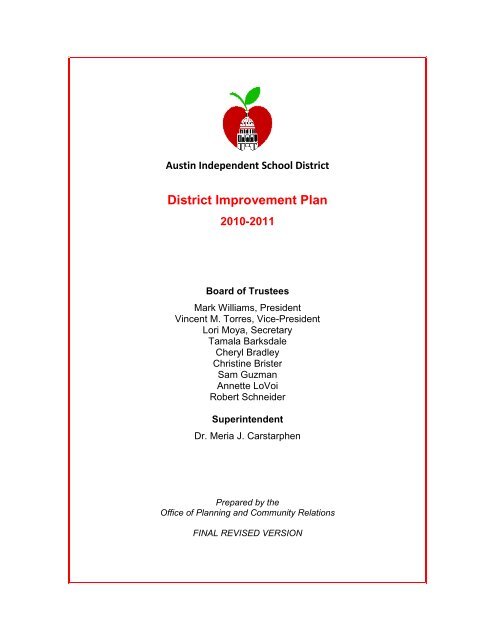
![Pageflex Server [document: PR1986512_00001] - Austin ISD](https://img.yumpu.com/27239252/1/190x245/pageflex-server-document-pr1986512-00001-austin-isd.jpg?quality=85)
